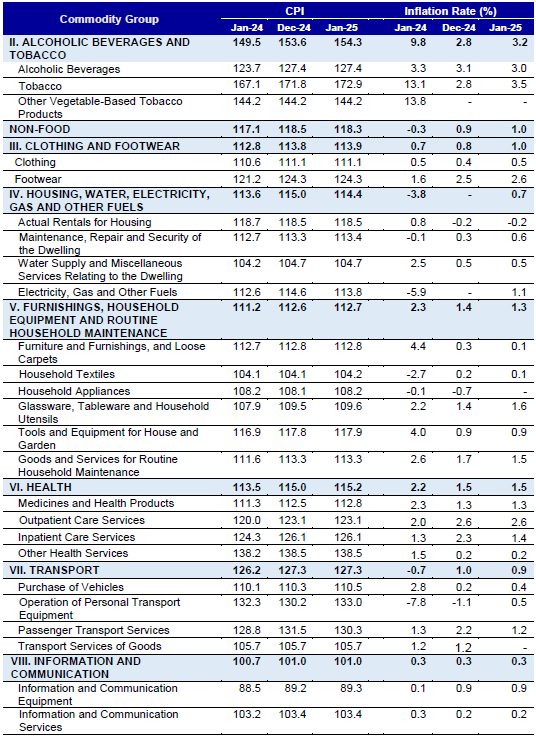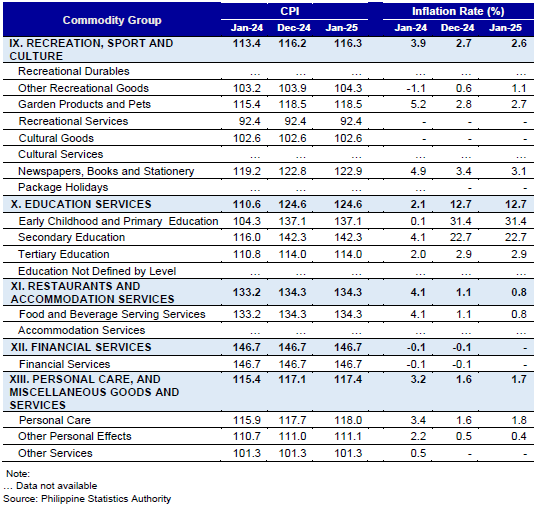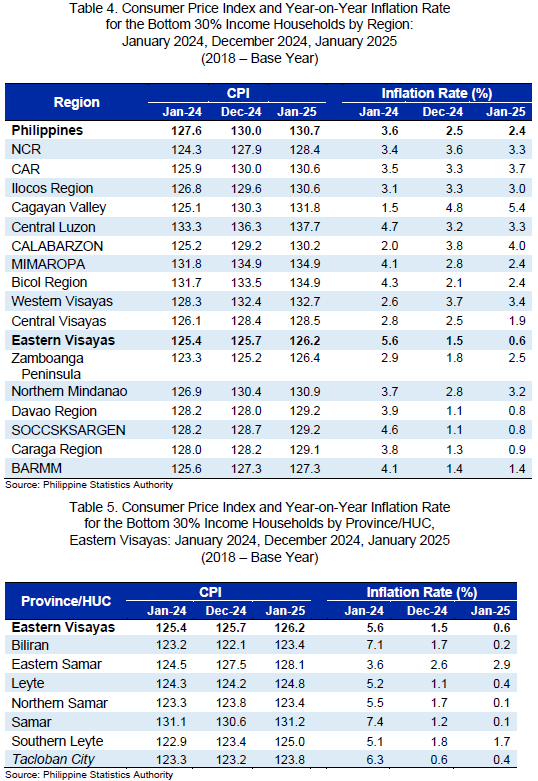
Eastern Visayas
The Inflation Rate (IR) for the bottom 30% income households in Eastern Visayas slowed down further to 0.6 percent in January 2025 from 1.5 percent in December 2024. This is the lowest IR for this income group since the 0.6 percent IR recorded in April 2020. Moreover, the regional IR for this income group was lower than the 2.4 percent national IR recorded in January 2025. The region’s IR in January 2024 was higher at 5.6 percent (Tables 1 and 2).

Main Drivers of the Downtrend of the Regional Inflation
The main driver to the deceleration of the regional inflation for the bottom 30% income households in January 2025 was the slower IR in the heavily weighted food and non-alcoholic beverages commodity group recorded at 0.2 percent from 1.7 percent in December 2024.
In addition, the following commodity groups recorded lower IRs during the month:
a. Restaurants and accommodation services, 0.8 percent from 1.1 percent;
b. Transport, 0.9 percent from 1.0 percent;
c. Furnishings, household equipment and routine household maintenance,
1.3 percent from 1.4 percent; and
d. Recreation, sport and culture, 2.6 percent from 2.7 percent.
On the other hand, compared with their IRs in December 2024, higher IRs were observed in the following commodity groups:
a. Alcoholic beverages, and tobacco, 3.2 percent from 2.8 percent;
b. Clothing and footwear, 1.0 percent from 0.8 percent;
c. Housing, water, electricity, gas and other fuels, 0.7 percent from 0.0 percent; and
d. Personal care, and miscellaneous goods and services, 1.7 percent from 1.6 percent.
Moreover, financial services recorded zero IR in January 2025 from an annual price decrease of 0.1 percent in December 2024.
Meanwhile, the commodity groups of health, information and communication, and education services retained their previous month’s IRs at 1.5 percent, 0.3 percent, and 12.7 percent, respectively.
Main Contributors to the Regional Inflation
The top three commodity groups that contributed to the January 2025 regional IR were the following:
a. Food and non-alcoholic beverages with 19.0 percent share or 0.11 percentage point;
b. Housing, water, electricity, gas and other fuels with 17.0 percent share or 0.10 percentage point; and
c. Alcoholic beverages and tobacco with 13.4 percent share or 0.08 percentage point.
Food Inflation
Food inflation for the bottom 30% income households in Eastern Visayas slowed down further to 0.2 percent in January 2025 from 1.7 percent in December 2024. In January 2024, food inflation was posted at 9.6 percent (Table 3).
The decline of food IR was primarily brought about by the annual price decrease in rice at 4.4 percent in January 2025 from 0.3 percent in December 2024. Meat and other parts of slaughtered land animals, which registered lower IR at 1.1 percent in January 2025 from 2.2 percent in December 2024, also contributed to the downtrend.
In addition, the commodity groups of fruits and nuts and fish and other seafood registered lower IRs at 3.5 percent and 3.8 percent in January 2025, from 4.3 percent and 3.9 percent in December 2024, respectively.
Furthermore, corn registered an annual price decline of 0.4 percent in January 2025 from 0.4 percent IR in December 2024.
In contrast, compared with their previous month’s IRs, higher IRs were observed in January 2025 in the following food groups:
a. Flour, bread and other bakery products, pasta products, and other cereals, 1.9 percent from 1.6 percent;
b. Milk, other dairy products and eggs, 1.9 percent from 1.7 percent;
c. Vegetables, tubers, plantains, cooking bananas and pulses, 8.2 percent from 2.9 percent; and
d. Ready-made food and other food products not elsewhere classified, 6.2 percent from 5.4 percent.
Moreover, slower annual price decreases were observed in oils and fats and sugar, confectionery and desserts at 0.1 percent and 2.3 percent in January 2025 from their annual price decreases of 0.5 percent and 2.4 percent in December 2024,
respectively.
Main Contributors to the Food Inflation
Food inflation shared 11.2 percent or 0.07 percentage point to the regional inflation for the bottom 30% income household in January 2025. The food groups with the highest contribution to the food inflation during the month were the following:
a. Fish and other seafood, with 7,156.6 percent share or 14.3 percentage points;
b. Vegetables, tubers, plantains, cooking bananas and pulses, with 6,740.6 percent share or 13.5 percentage points; and
c. Ready-made food and other food products not elsewhere classified, with 2,406.5 percent share or 4.8 percentage points.
Inflation Rate by Region

In comparison with their IRs in December 2024, nine (9) regions registered lower IRs for the bottom 30% income households in January 2025, seven (7) recorded higher IRs while the remaining one (1) retained its previous month’s IR. In January 2025, the lowest IR for this income group was observed in Eastern Visayas at 0.6 percent, while the highest IR was recorded in Cagayan Valley at 5.4 percent (Figure 2 and Table 4).
Inflation Rate by Province

Relative to their IRs for the bottom 30% income households in December 2024, the lone Highly Urbanized City (HUC) Tacloban City and all the provinces, except Eastern Samar, recorded lower IRs in January 2025. For this income group, Eastern Samar registered the highest IR among the provinces at 2.9 percent. This was followed by Southern Leyte at 1.7 percent, Leyte at 0.4 percent, and Biliran at 0.2 percent. The lowest IR for this income group was noted in Northern Samar and Samar both at 0.1 percent. Meanwhile, IR for the bottom 30% income households in Tacloban City was recorded at 0.4 percent in January 2025 (Figure 3 and Table 5).




TECHNICAL NOTES
The CPI for the bottom 30% income households is compiled by the PSA to measure the changes of prices of commodities commonly purchased by the families that belong to the bottom 30% income decile. The
process of price collection and CPI computation is the same as that of the CPI for all income households.
However, there is a separate market basket and weights for the CPI for the bottom 30% income households.
BASE YEAR - is a period at which the index number is set to 100. It is the reference point of the index number series. The CPI is rebased from 2012 to 2018.
CONSUMER PRICE INDEX (CPI) - is an indicator of the change in the average prices of a fixed basket of goods and services commonly purchased by households relative to a base year.
DEFLATION - is the decline in prices for goods and services that happens when the inflation rate dips below zero percent.
INFLATION RATE (IR) - is the annual rate of change or the year-on-year changes in CPI. It indicates how fast or how slow price changes over two time periods (year-on-year). Contrary to common knowledge, low inflation does not necessarily connote that prices of commodities are falling. It means that prices continue to increase but at a slower rate.
MARKET BASKET - refers to a sample of goods and services commonly purchased by the households. The market basket for CPI was updated using the results of the 2021 Survey of Key Informants (SKI). The commodities included in the 2018-based CPI market basket were the modal commodities which were considered as the most commonly purchased/availed commodities by the households. The commodities in the 2018-based CPI market basket were grouped/classified according to the 2020 Philippine Classification of Individual Consumption According to Purpose (PCOICOP).
MONITORING OF PRICES - involves establishing baseline information for the prices of the items in the base year and monitoring the prices of the items on a regular basis. Data collection for the CPI is done by the provincial office twice a month, except for petroleum products which are monitored on a weekly basis, every Friday. First collection phase is done during the first five days of the month while the second phase is on the 15th to 17th day of the month.
PURCHASING POWER OF PESO (PPP) - gives an indication of the real value of peso (how much it is worth) in a given period relative to its value in the base period. It is computed as the reciprocal of CPI multiplied by 100.
RETAIL PRICE - refers to the actual price at which retailers sell a commodity on spot or earliest delivery, usually in small quantities for consumption and not for resale. It is confined to transactions on cash basis in the free market and excludes underground prices and prices of commodities that are on sale as in summer sales, anniversary sales, Christmas sales, etc.
WEIGHTS - is a value attached to a commodity or group of commodities to indicate the relative importance of that commodity or group of commodities in the market basket. The weights for the 2018-based CPI were derived from the expenditure data of the 2018 Family Income and Expenditure Survey (FIES). The weight for each commodity/group of commodities is the proportion of the expenditure commodity/group of commodities to the total national expenditure. The sum of the weights of the commodity groups at the national level is equal to 100.
SGD. WILMA A. PERANTE
Regional Director

